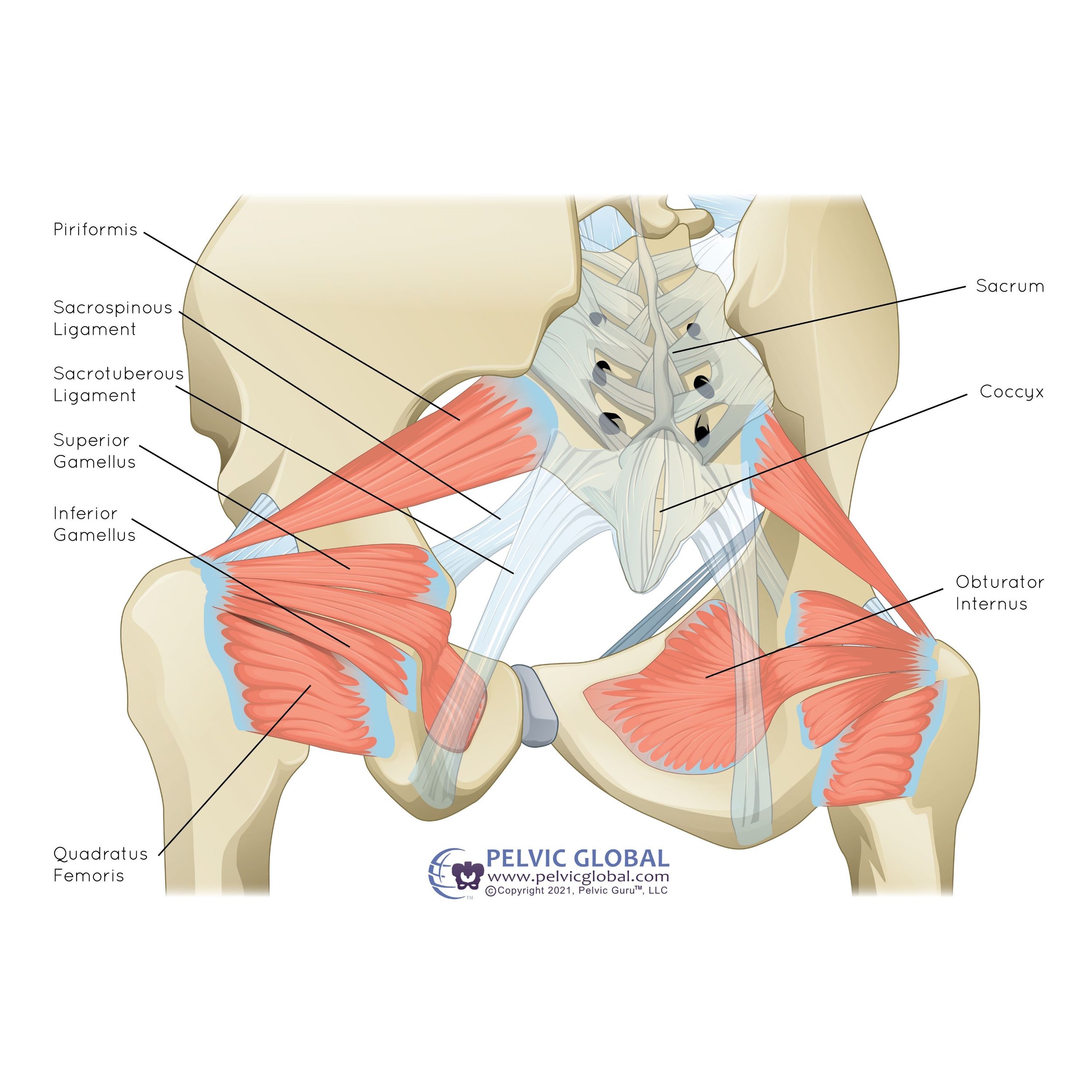Self Obturator Internus Release: How This Pesky Muscle Can Provide Pelvic Relief
Relieving Pelvic Pain Through Self Obturator Internus Release
Introduction
Ever felt a deep, nagging pain in your pelvis or hip and couldn’t figure out where it was coming from? Or do you have sciatica that never seems to resolve? Do you feel rectal fullness, like you’re sitting on a golf ball? These symptoms are common in many pelvic conditions like chronic prostatitis, coccydynia, or unresolved hip or back pain. Tightness or dysfunction in the pelvic floor muscles, especially the obturator internus, may be the culprit. The good news? There are ways to release this muscle yourself.
In this blog, we'll discuss how to alleviate pelvic pain and other symptoms through self-release techniques.
Understanding the Obturator Internus
The Role of the Obturator Internus
The obturator internus is a deep muscle located inside the pelvis and hip. It helps with external hip rotation and pelvic stabilization. When tight or overactive, it can contribute to pelvic discomfort, reduced hip mobility, pelvic floor dysfunction, and unresolved hip or back pain.
Pelvic Pain and the Obturator Internus
Pelvic pain can stem from various factors, including muscle tightness, nerve irritation, or underlying medical conditions. Often overlooked, the obturator internus can cause referral pain patterns, manifesting as tailbone pain, anal pain or pressure, discomfort down the back of the thigh, deep hip pain, or buttock pain.
Unresolved Hip and Back Pain
The obturator internus is frequently neglected in cases of unresolved hip, sciatica, or back pain. Standard treatments typically focus on the glutes, back muscles, or hip/core strengthening. While these are crucial, deeper pelvic floor muscles, like the obturator internus, also play a role. Ignoring them may leave a part of the problem untreated.
This illustration highlights the unique location of the obturator internus and its surrounding structures, showing its role as both a hip muscle and a pelvic floor muscle.
How Self-Obturator Internus Release Can Help
Taking Charge of Your Pelvic Health with Self-Management
By learning self-release techniques, you can target the obturator internus directly, reducing tension and alleviating pain. This empowers you to manage your pelvic health and complements professional pelvic physical therapy.
How to Perform Self-Obturator Internus Release
Preparation and Precautions
Before beginning, it's essential to:
Consult a Professional: Always speak with a healthcare provider or pelvic floor physical therapist to ensure these techniques are appropriate for you.
Understand Your Anatomy: Familiarize yourself with the pelvic floor muscles. Looking at a 3D pelvic floor model with a pelvic therapist can help you locate these muscles and target them effectively during release work.
Obturator Internus Release Techniques
Hip External Rotation Stretching
This stretch targets the deep hip rotators indirectly:Start Seated: Sit on a chair with your back upright.
Cross Your Leg: Bend your right knee and place your right ankle over your left knee.
Apply Gentle Pressure: Lean forward toward your leg until you feel a stretch in your right hip.
Hold and Switch: Hold for 30 seconds, then switch sides.
Foam Roller Technique
Using a foam roller can massage the deep muscles of the pelvic floor, helping relax the obturator internus:Positioning: Sit on a foam roller placed under your buttocks.
Apply Pressure: Tilt your body slightly to target the desired side. Hold gentle pressure while performing deep breathing.
Rolling Motion: Gently roll back and forth to massage the pelvic floor muscles.
Duration: Continue for 1-2 minutes on each side.
Internal Pelvic Release (Advanced)
Note: This technique should only be performed if advised by a qualified pelvic floor therapist.Pelvic Wand: Insert a lubricated pelvic wand into the vaginal canal (for females) or rectum (for males or females) as directed by your therapist.
Apply Pressure: Turn the wand gently toward the side of the pelvic floor to release tension. Discomfort should not exceed 3/10. Hold for 5-10 seconds, then release.
Breathe Deeply: Maintain deep breathing for relaxation.
The above illustration shows how pelvic wands can target the obturator internus in females for self pelvic floor release work.
The Science Behind the Techniques
How Muscle Release Works
Releasing tension in the obturator internus improves blood flow, stabilizes the hip, and supports better posture. Combined with hip and core stabilization exercises from a physical therapist, this release work can relax the muscle and prevent future tightness.
Additionally, releasing this muscle can reduce nerve irritation, alleviating pelvic pain or sciatica-like symptoms. The nearby sciatic, pudendal, and posterior femoral cutaneous nerves can be impacted by tension in the obturator internus. Releasing these muscles helps alleviate nerve-related pain.
The above picture illustrates the close proximity of the obturator internus to the pudendal nerve, sciatic nerve, and posterior femoral cutaneous nerve.
When to Seek Professional Help
Recognizing Limitations
While self-release techniques are helpful, they may not resolve all underlying issues. Seek professional help if you experience:
Persistent pain with no improvement after several weeks.
Severe discomfort during or after exercises.
Additional symptoms like numbness or changes in bowel or bladder function.
Temporary relief with internal work, but not long-lasting.
Professional Interventions
A pelvic physical therapist can offer more targeted treatments, including:
Manual Therapy: Hands-on soft tissue work or myofascial release to relax deep muscles.
Mobility or Relaxation Exercises: Exercises to help relax the pelvic floor and improve hip or back mobility.
Strengthening Exercises: Hip or abdominal exercises to provide support and encourage the obturator internus to relax.
Conclusion
Pelvic pain doesn’t have to be a lifelong burden. By understanding the role of the obturator internus and applying self-release techniques, you can take steps toward relief. These methods are most effective as part of a holistic approach, including professional guidance.
Take the Next Step
Ready to reclaim your comfort? Start incorporating these techniques into your routine today. Don't hesitate to reach out to a pelvic physical therapist for personalized support.
Always consult a healthcare professional before starting any new exercise regimen or performing self-release work. This guide is for informational purposes and is not a substitute for medical advice.
Engage with Us
If you found this guide helpful, please share it with others. Have questions or success stories? Leave a comment below—we’d love to hear from you!
Our content is grounded in expertise and backed by the latest research to provide trustworthy information for your health journey.
Written By,
Dr. Jana Richardson, PT, DPT, WCS, PRPC, CIDN
Dual Board Certified Pelvic Floor Therapist and Owner of Chicago Pelvic Health
Dr. Jana Richardson is a highly accomplished pelvic floor therapist with dual board certifications and extensive experience in treating complex pelvic floor dysfunctions. As the owner of Chicago Pelvic Health, Dr. Richardson is dedicated to providing personalized and effective care for her patients. With a Doctorate in Physical Therapy, and specialized certifications in Women’s Health and Pelvic Rehabilitation, Dr. Richardson is a leading expert in her field. She is also certified in Integrative Dry Needling, further enhancing her ability to offer comprehensive treatment plans. Dr. Richardson’s commitment to patient-centered care and her passion for helping individuals achieve optimal pelvic health make her an invaluable asset to the community.











Pelvic congestion can be a silent disruptor, affecting your comfort, confidence, and daily life. In this comprehensive guide, I share insights from my experience as a dual board-certified Pelvic PT on identifying symptoms, understanding causes, and exploring pelvic physical therapy solutions. Discover how effective, specialized care can help you overcome pelvic congestion and reclaim your well-being.